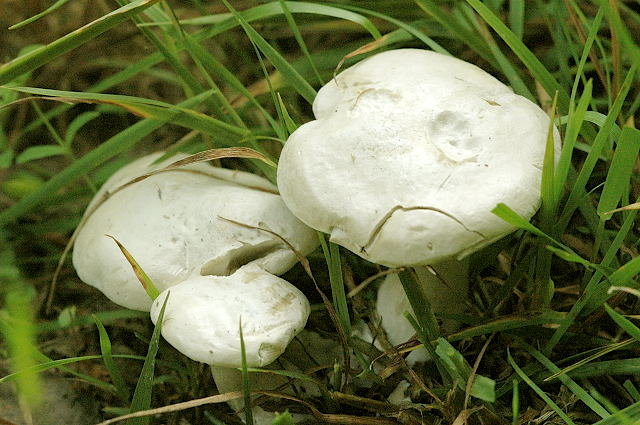Talker whitish (Clitocybe rivulosa)
- Diviziona: Basidiomycota (Basidiomycetes)
- Fizarana: Agaricomycotina (Agaricomycetes)
- Kilasy: Agaricomycetes (Agaricomycetes)
- Kilasy: Agaricomycetidae (Agaricomycetes)
- Karazana: Agaricales (Agarika na Lamellar)
- Fianakaviana: Tricholomataceae (Tricholomovye na Ryadovkovye)
- Karazana: Clitocybe (Clitocybe na Govorushka)
- Type: Clitocybe rivulosa (whitish talker)

mpanao resaka fotsy, notapahina, na tsy niova loko (Ny t. clitocybe dealbata), koa Reddish talker, na furrowed (Ny t. Clitocybe rivulosa) dia karazana holatra anisan'ny karazana Govorushka (Clitocybe) an'ny fianakaviana Ryadovkovye (Tricholomataceae).
The whitish talker grows on the soil or on the litter in places with grass cover – in meadows and pastures or on edges, clearings and clearings in deciduous and mixed forests, as well as in parks. Fruiting bodies appear in groups, sometimes very large; form “witch circles”. Distributed in the temperate zone of the Northern Hemisphere.
Season from mid-July to November.
The cap of the talker is whitish ∅ 2-6 cm, in young mushrooms, with a tucked edge, later – in old mushrooms – or, often with a wavy edge. The color of the cap varies from powdery white and whitish-grayish in young mushrooms to buffy in mature ones. Mature mushrooms have indistinct grayish spots on the cap. The surface of the cap is covered with a thin powdery coating, which is easily removed; in wet weather it is a little slimy, in dry weather it is silky and shiny; when dry, it cracks and becomes lighter.
The flesh (3-4 mm thick on the cap disc), and, whitish, does not change color when cut. The taste is inexpressive; musty smell.
The stem of the talker is whitish, 2–4 cm long and 0,4–0,6 cm ∅, cylindrical, slightly tapering towards the base, straight or curved, solid in young mushrooms, later hollow; the surface is whitish or grayish, in places covered with hazel-colored spots, darkening when pressed, longitudinally fibrous.
The plates are frequent, whitish, later grayish-whitish, becoming light yellow in maturity, descending on the stem, 2-5 mm wide.
Spore powder is white. Spores 4-5,5 × 2-3 µm, ellipsoid, smooth, colorless.
Deadly poisonous olatra!
It grows on the soil or on the litter in places with grass cover – in meadows and pastures or on edges, clearings and clearings in deciduous and mixed forests, as well as in parks. Fruiting bodies appear in groups, sometimes very large; form “witch circles”. Distributed in the temperate zone of the Northern Hemisphere.
Season from mid-July to November.
In the literature, two species have often been distinguished – Clitocybe rivulosa with a pinkish cap and plates and a short stem and Clitocybe dealbata with a grayish color and a longer stem. These factors turned out to be insufficient for separation; the color of hygrophan talkers significantly depends on the degree of wetting. Molecular genetic studies have also concluded that there is one polymorphic species.









